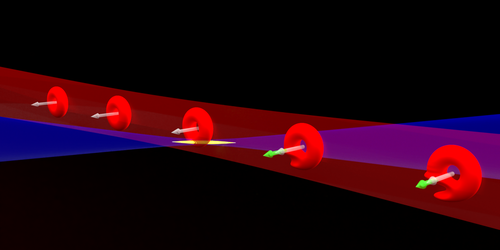Applying a Twist to Light
In 2016 Howard Milchberg of the University of Maryland, College Park, and his students observed that previously unrecognized electromagnetic structures form around a self-focusing light pulse (see Focus: Smoke Rings in Light). These so-called spatiotemporal optical vortices (STOVs) wrapped toroidally around the pulses. STOVs possess orbital angular momentum that points perpendicular (transverse) to the direction of pulse propagation, quite unlike the usual longitudinal orbital angular momentum. Now Milchberg and a new group of students have demonstrated a way to impart a precise amount of this transverse orbital angular momentum to a STOV-wrapped pulse propagating in free space [1]. In doing so, the researchers determined the amount of transverse orbital angular momentum a photon in such a structure can carry, a step they say is crucial for future applications, such as optical communications.
To generate STOVs without the need for self-focusing, Milchberg’s team arranged a sequence of gratings, lenses, and a special phase-shifting element through which they shone a pulsed laser. The STOVs emerging from this device resembled flying donuts spinning around an axis oriented perpendicular to the laser’s propagation direction and moving at the speed of light.
The team then used another pulsed laser to generate a thin, fleeting plasma at a controllable time and location in each STOV’s path. The plasma perturbed the refractive index of the air through which the STOVs moved. The interaction of each STOV with the plasma imparted either a positive or a negative transverse twist to the STOV, increasing or decreasing its orbital angular momentum. Comparing experimental values of the twist with theoretical predictions, the team was able to infer the amount of transverse orbital angular momentum carried per photon.
–Charles Day
Charles Day is a Senior Editor for Physics Magazine.
References
- S. W. Hancock et al., “Spatiotemporal torquing of light,” Phys. Rev. X 14, 011031 (2024).




